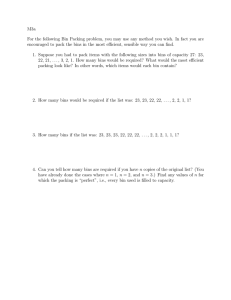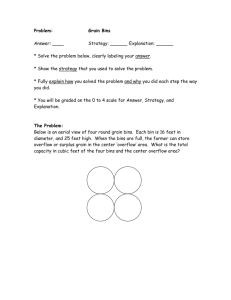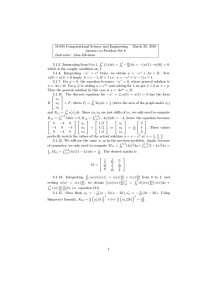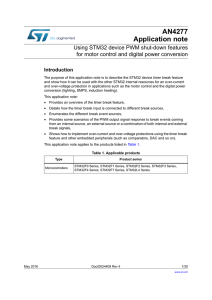Math 3080 § 1. Pregnancy Example: χ Goodness of Fit Test Name:
advertisement
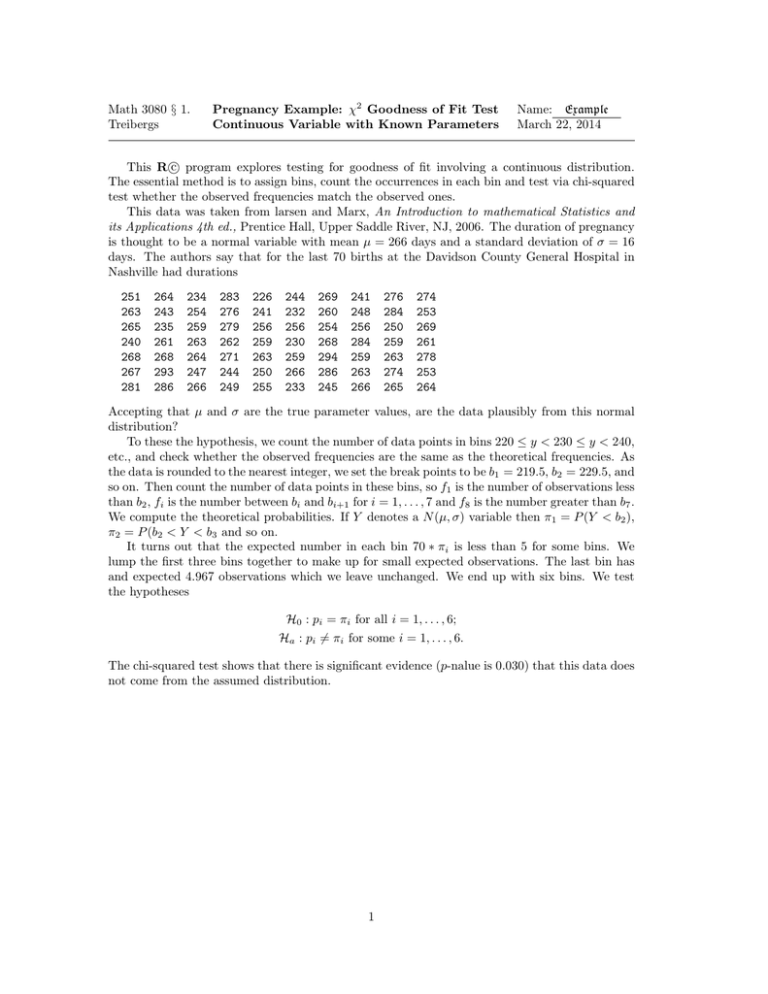
Math 3080 § 1. Treibergs Pregnancy Example: χ2 Goodness of Fit Test Continuous Variable with Known Parameters Name: Example March 22, 2014 c program explores testing for goodness of fit involving a continuous distribution. This R The essential method is to assign bins, count the occurrences in each bin and test via chi-squared test whether the observed frequencies match the observed ones. This data was taken from larsen and Marx, An Introduction to mathematical Statistics and its Applications 4th ed., Prentice Hall, Upper Saddle River, NJ, 2006. The duration of pregnancy is thought to be a normal variable with mean µ = 266 days and a standard deviation of σ = 16 days. The authors say that for the last 70 births at the Davidson County General Hospital in Nashville had durations 251 263 265 240 268 267 281 264 243 235 261 268 293 286 234 254 259 263 264 247 266 283 276 279 262 271 244 249 226 241 256 259 263 250 255 244 232 256 230 259 266 233 269 260 254 268 294 286 245 241 248 256 284 259 263 266 276 284 250 259 263 274 265 274 253 269 261 278 253 264 Accepting that µ and σ are the true parameter values, are the data plausibly from this normal distribution? To these the hypothesis, we count the number of data points in bins 220 ≤ y < 230 ≤ y < 240, etc., and check whether the observed frequencies are the same as the theoretical frequencies. As the data is rounded to the nearest integer, we set the break points to be b1 = 219.5, b2 = 229.5, and so on. Then count the number of data points in these bins, so f1 is the number of observations less than b2 , fi is the number between bi and bi+1 for i = 1, . . . , 7 and f8 is the number greater than b7 . We compute the theoretical probabilities. If Y denotes a N (µ, σ) variable then π1 = P (Y < b2 ), π2 = P (b2 < Y < b3 and so on. It turns out that the expected number in each bin 70 ∗ πi is less than 5 for some bins. We lump the first three bins together to make up for small expected observations. The last bin has and expected 4.967 observations which we leave unchanged. We end up with six bins. We test the hypotheses H0 : pi = πi for all i = 1, . . . , 6; Ha : pi 6= πi for some i = 1, . . . , 6. The chi-squared test shows that there is significant evidence (p-nalue is 0.030) that this data does not come from the assumed distribution. 1 R Session: R version 2.14.0 (2011-10-31) Copyright (C) 2011 The R Foundation for Statistical Computing ISBN 3-900051-07-0 Platform: i386-apple-darwin9.8.0/i386 (32-bit) R is free software and comes with ABSOLUTELY NO WARRANTY. You are welcome to redistribute it under certain conditions. Type ’license()’ or ’licence()’ for distribution details. Natural language support but running in an English locale R is a collaborative project with many contributors. Type ’contributors()’ for more information and ’citation()’ on how to cite R or R packages in publications. Type ’demo()’ for some demos, ’help()’ for on-line help, or ’help.start()’ for an HTML browser interface to help. Type ’q()’ to quit R. [R.app GUI 1.42 (5933) i386-apple-darwin9.8.0] [Workspace restored from /home/1004/ma/treibergs/.RData] [History restored from /home/1004/ma/treibergs/.Rhistory] > x=scan() 1: 251 264 234 283 226 244 269 241 276 274 11: 263 243 254 276 241 232 260 248 284 253 21: 265 235 259 279 256 256 254 256 250 269 31: 240 261 263 262 259 230 268 284 259 261 41: 268 268 264 271 263 259 294 259 263 278 51: 267 293 247 244 250 266 286 263 274 253 61: 281 286 266 249 255 233 245 266 265 264 71: Read 70 items > max(x); min(x) [1] 294 [1] 226 > ################ SET BIN BREAKS ################################ > brk=seq(219.5,299.5,10);brk [1] 219.5 229.5 239.5 249.5 259.5 269.5 279.5 289.5 299.5 > > ################ PLOT A HISTOGRAM AND DO FREQUENCY COUNTS ######$ > h1=hist(x,breaks=brk,right=F,freq=F,main="Pregnancy Durations") > curve(dnorm(x,266,16),add=T,col=2,lwd=5) > > fr=h1$counts; fr [1] 1 5 10 16 23 7 6 2 > 2 > ########### COMPUTE THE PROBABILITY FOR EACH BIN ################# > pi=c(pnorm(brk[2],266,16),pnorm(brk[3:8],266,16)-pnorm(brk[2:7],266,16), pnorm(brk[8],266,16,lower.tail=F)) > > ######## TABLE OF OBSERVED VS EXPECTED FREQUENCIES ################ > rbind(fr,70*pi) [,1] [,2] [,3] [,4] [,5] [,6] [,7] [,8] fr 1.000000 5.000000 10.000000 16.00000 23.00000 7.00000 6.000000 2.000000 0.788678 2.629814 7.166334 13.37474 17.10087 14.98125 8.991798 4.966521 > ############# LUMP FIRST THREE BINS TOGETHER ####################### > fr2=c(fr[1]+fr[2]+fr[3],fr[4:8]) > pi2=c(pi[1]+pi[2]+pi[3],pi[4:8]) > sum(fr2);sum(pi2) [1] 70 [1] 1 > rbind(fr2,70*pi2) [,1] [,2] [,3] [,4] [,5] [,6] fr2 16.00000 16.00000 23.00000 7.00000 6.000000 2.000000 10.58483 13.37474 17.10087 14.98125 8.991798 4.966521 > ###### CHI-SQ TEST FOR OBSERVED VS THEORETICAL FREQUENCIES > chisq.test(fr2,p=pi2) ########## Chi-squared test for given probabilities data: fr2 X-squared = 12.34, df = 5, p-value = 0.03041 Warning message: In chisq.test(fr2, p = pi2) : Chi-squared approximation may be incorrect > 3 0.000 0.005 0.010 0.015 Density 0.020 0.025 0.030 Pregnancy Durations 220 240 260 x 4 280 300

